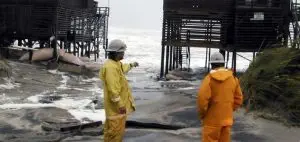
- Sea level rise in the contiguous United States is expected to make tidal flooding worse, which puts 311,000 homes worth about $117.5 billion at risk of chronic flooding over the next 30 years, according to a study from the Union of Concerned Scientists (UCS).
- The number of at-risk homes is projected to climb to 2.4 million, worth $912 billion, by the end of the century.
- States most at risk of being affected by the end of the century are Florida, with 1 million homes; New Jersey, with 250,000 homes; and New York, with 143,000 homes. In addition to chronically flooded areas becoming unlivable, the most at-risk communities could lose billions in tax revenue that funds services such as schools, roads and emergency services.
- The cost of sea level rise is expected to disproportionately affect low-income and rural areas. The report identified 75 communities where about 30% of the property tax base is at risk, and about one-third of those have poverty rates higher than the national average. The hardest hit communities by this metric will be in Louisiana, Maryland, New Jersey and North Carolina.
This study does not bode well for communities that are already experiencing the effects of sea level rise. South Florida, which is an area of particular concern in the UCS study, is a prime example. Sea level rise in cities like Miami has become so well known that leaders and organizations are actively looking for ways to mitigate the problem. For example, this spring the Knight Foundation granted the Harvard University Graduate School of Design $1 million for a three-year study to come up with solutions to Miami’s and Miami Beach’s most pressing sustainability and resiliency challenges, including climate change.
UCS suggests that the easiest and most impactful action for cities to take is changing policies that either exacerbate or do not work to combat the growing flood risk impact on homes. Inaccurate flood risk information, subsidized insurance, zoning codes, building codes and incentives are issues on which cities can improve. Cities can, for example, reexamine and update their flood plain map and then implement zoning changes to prevent or limit further residential development in flood-prone areas.
Leave a Reply